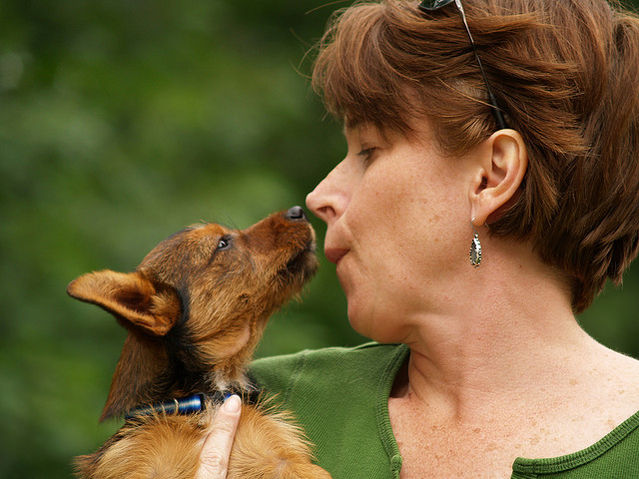Conscientiousness
Nose to Nose Greeting With Puppies
Nose to nose touches may be a safe addition to puppy socialization.
Posted October 29, 2015

Last night I had the opportunity to visit with a group of seven-week-old Nova Scotia Duck Tolling Retriever puppies. Since I hope to be able to have one of the boys from the litter I played with them at bit, and then lifted each one to my face and touched my nose to theirs. This is my version of the nose-to-nose greeting that dogs often use. It is quite common for adult dogs to engage in nose touching with puppies. Dogs also frequently use nose touches when greeting other non-threatening species. A quick scan of the many images that you can find on the Internet will find you dozens of photographs of dogs touching noses with cats, kittens, horses, and young children (usually when they happened to be crawling across the floor).
Although nose-to-nose touches are primarily a greeting, they also can serve as a method of gathering information about the other individual (click here to see more about that). When I engage in nose-to-nose touching of a young puppy, I am not only trying to engage in a friendly greeting, but I am looking at how the puppy responds. I believe that the puppy who responds fearfully, or who turns away and refuses to make eye contact might well grow up to be a timid dog. The pups that I'm looking for are the ones that look directly at me, and then perhaps give a positive social response such as licking at my face.
The breeder, who has veterinary training, and is extremely knowledgeable and conscientious in her breeding and puppy rearing methods, watched while I touched my nose to one of the bigger, more active, male puppies. She then warned "Watch out or you will get your nose bitten!"
It is certainly the case that attempting a nose-to-nose touch with an adult dog is not really advisable unless you are very familiar with the dog, and sure about its reactions. Take, as an example, the case of Meggie, the Scottish Terrier that President Franklin Delano Roosevelt owned before the arrival of his most famous dog, Fala. Meggie had developed into a pushy dog, however Roosevelt's wife Eleanor refused to let anyone discipline her. So Meggie terrorized the housemaids at the White House by chasing them down the halls and biting at their brooms, mops, and dusters. Word about her rowdy behavior had leaked out and the famous newspaper reporter Bess Furman decided to explore the story a bit further. During an interview with the president (which actually focused on more serious matters) she brought up the issue of Meggie's delinquency. Roosevelt laughed and said "I am not with her all of the time, perhaps you had best ask her about these reports."
Furman patted the seat beside her and Meggie responded to the invitation by jumping up on the sofa. Then, Furman looked directly into the Terrier's eyes as she asked in a serious voice "Meggie, have you been a naughty dog? Come now and confess to the public what you have really done." The Terrier's response was to give the reporter a sharp bite on her nose!
On the other hand, some puppy breeders believe that nose-to-nose touching should be part of the socialization process for young dogs. I know that it is used by one well-known breeder of Corgis. These dogs are bred to nip at the feet of sheep and cattle in order to move them. This inborn trait often results in Corgis also using their teeth to nip at anyone who annoys them in any way. For example, the Queen of England has been bitten several times by her Corgis. However this Corgi breeder uses nose-to-nose touching several times each day with her litters of puppies. She tells me that she has never once been bitten or snapped at by a puppy. Furthermore, although she has not kept systematic records, she claims that as a result her dogs are much less likely to try to bite people when they mature.
I also believe that it is highly unlikely that a puppy will act aggressively if you attempt a nose-to-nose greeting. This seems to be confirmed in an article recently accepted for publication in The Veterinary Journal*. A team of researchers headed by Petr Rezac from the Department of Animal Morphology, Physiology and Genetics at the Mendel University in the Czech Republic gathered complete data on 132 incidents where people were bitten in the face. The most likely action to trigger a bite on the face is when a human abruptly bends over a dog (76%). People who place their faces very near to the dog's face may also trigger a bite (19%), while gazing into the dog's eyes closely accounts for 5%. In this data set every one of the bites to the face came from an adult dog — not one incident involved a puppy biting a human's face during an interaction.
While the socialization value of nose-to-nose touching in puppies is still only anecdotal, it does seem, on the basis of this data, that you are not placing your own nose in jeopardy when you greet a puppy in this manner.
Stanley Coren is the author of many books including: The Wisdom of Dogs; Do Dogs Dream? Born to Bark; The Modern Dog; Why Do Dogs Have Wet Noses? The Pawprints of History; How Dogs Think; How To Speak Dog; Why We Love the Dogs We Do; What Do Dogs Know? The Intelligence of Dogs; Why Does My Dog Act That Way? Understanding Dogs for Dummies; Sleep Thieves; The Left-hander Syndrome
Copyright SC Psychological Enterprises Ltd. May not be reprinted or reposted without permission
* Data From: P. Rezac, K. Rezac, and P. Slama, (2015). Human behavior preceding dog bites to the face. The Veterinary Journal, http://dx.doi.org/doi:10.1016/j.tvjl.2015.10.021.


